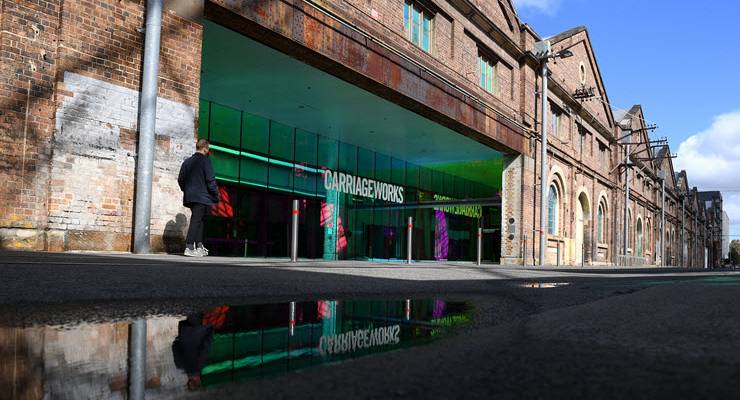
Sydney arts venue Carriageworks became one of COVID-19’s victims this week.
Its board announced on Monday that it had appointed voluntary administrators following the sustained effects of cancellations across the arts.
Galleries in Australia are facing the same uncertain future as every other sector in the country, and like other sectors it’s showing up problems that have been present for a long time.
An immediate concern is the issue of donations. Arts organisations in Australia are hugely reliant on donations and bequests. To pick one example, the Art Gallery of New South Wales received $103.5 million from private donors in addition to government funding in 2018.
National Association of Visual Artists (NAVA) chief executive officer Esther Anatolitis said the fallout from the pandemic highlighted long-term issues.
“Philanthropists and artists I’ve spoken to have huge concerns about philanthropy and donations contracting,” she said.
“The philanthropists I’ve spoken to are overwhelmed — there are so many people and organisations, obviously, that need help right now.”
Monash University lecturer and arts writer Ben Eltham told Crikey that the effects of a financial crisis went beyond people’s ability or willingness to donate.
“Philanthropic donations to cultural institutions are highly procyclical,” he said. “In boom times, galleries, museums and other cultural non-profits can enjoy windfall donations from cashed up billionaires looking for the social cachet that benefaction can bring, not to mention a handy tax deduction provided by the recipient’s charity status.
“But in times of economic crisis, there’s a lot less donor cash to go round. Not only have many benefactors taken a hit on their investment portfolios, but the sea of red ink means there’s no need to go looking for tax hedges.”
Further, the pandemic has shut down the “glitzy openings and clubbable vernissages that big institutions used to wine and dine prospective donors,” Eltham said. “It’s a perfect storm.”
The almost-certain drop in donations brings into sharper relief the long-term funding issues the industry faces, particularly since what the industry calls the “Brandis raid” in 2015.
Australia’s national cultural institutions — including the National Gallery of Australia, the Museum of Australian Democracy, the Australian Museum — face the same “efficiency dividend” as other Commonwealth agencies.
Curiously, the Australian War Memorial, nominally subject to the same rules, still netted an extra half a billion dollars to expand late last year.
“[A crisis like this] really exposes how little helpful or strategic thinking about the arts sector there is at a government level,” Anatolitis said.
“These issues have compounded in the five years since the Brandis raid, as arts funding in that time has contracted considerably, and arts organisations are finding ongoing operational funding harder to get.”
And after the crisis hit, the stimulus directed at the arts industry (such as it is) misses the majority of workers in an industry dominated by casual and contract work.
The libraries, museums, performing arts and music sectors collectively produced around A$8.1 billion in economic output in 2020. As Eltham argued in The Conversation, providing the industry with a 2% stimulus would tally up to “around A$186 million — barely a rounding error in the context of the Morrison government’s spend”.
In the US we have seen cultural institutions stretched to the point that the powerful Association of Art Museum Directors, in an unprecedented move, relaxed its strict guidelines around selling valuable art works to stay afloat.
Anatolitis said any move of that sort would likely be a “last resort” for any Australian galleries.
“Generally it would be the last thing a gallery would want to do,” she said, citing the example of Jackson Pollock’s Blue Poles, owned by the National Gallery and which right-wing politicians argue should be sold from time to time: “It has a dollar value of course, but its ongoing value, in terms of the visitors it attracts, the prestige it brings, is very hard to quantify.”
Indeed, NAVA has asked that the government increase the acquisitions budgets of our key national institutions as a priority.
After the Carriageworks announcement, one proposal being considered by the NSW government is that the Sydney Opera House would take over operations, though that’s prompted immediate push back.
Anatolitis said it was an example of the lack of strategic thinking on arts policy.
“They are completely distinct, they have different communities, different approaches to art,” she said. “The idea they could be homogonised is fanciful at best and deeply disappointing at worst.”








No responses yet? Perhaps nobody cares anymore. Australian theatre has been dying ever since it was born in Melbourne in the 70s. This may be because fresh talent is discouraged by the snobbery and pretension that prevails in its curatorship.
Well you’ve my response now, Rev! I think you’ll find most people on this site prefer the culture war sniping that preoccupied them before the Covid crisis, or incorporating this new “unprecedented” reality into their old battles. All pretty irrelevant now, but maybe I’m guilty of a bit of that too. bBut only because I have nothing better to do!
Unemployment. What a bore…
Thetre born in Melbourne? In the 70s?
Try The New Theatre, a community theatre company in the inner western Sydney suburb of Newtown, Australia. Established in October 1932, it is the oldest theatre company in continuous production in Australia.
Poor little cabbage patchers down Mexico way, delusions of adequacy.
My work life ended in March – the industry in which I’d happily made a living in for 40 years (movie exhibition) was closed down by government edict. Oh well, I was nearing retirement anyway… and I wasn’t the only one suddenly staring at an empty work diary… With the lockdown, countless arts and entertainment related businesses have now simply ceased to exist. Re-starting (when?) will not be easy…
Pretty well all my colleagues, most of my friends and family – all of whom have eked out a precarious living in the arts and entertainment arena, are now unemployed. Very few are eligible for any (save the dole) of the assistance packages available to the unionised, well-connected and “more important” bits of the economy, as most were casuals, gig workers, self employed sole traders, or operators of micro-businesses. They way most used to supplement incomes (in food service and hospitality), is also unavailable.
Cinemas chains are putting on a brave face – most have still got a publicist (a casual probably, working from home) pumping out bright newsletters about what lies ahead in August, maybe… When they’re allowed to reopen, with “appropriate social distancing” of course.
But how many people will be going to the cinema? To the next Sydney Theatre Company performance? Potential customers have told their lives are in mortal danger… And judged by how many are still obediently indoors, cowering in fear and Netflixed into stupefaction, may never go out again.
What business model that only permits one third to one quarter of available seats to be sold for any given session survive? Oh, until the vaccine, of course… I get it! But now many cinemas, art venues theatres, art galleries, pubs with live music, gig venues will still be standing then?
Stupid question… Anyway, the cinema chains (my ex-clients) many find that even their retail landlords will have filed for bankruptcy before then.
second last par correction: What business model that only permits one third to one quarter of available seats to be sold for any given session will survive? Oh, until the vaccine, of course… I get it! But how many cinemas, art venues theatres, art galleries, pubs with live music, gig venues will still be standing then?